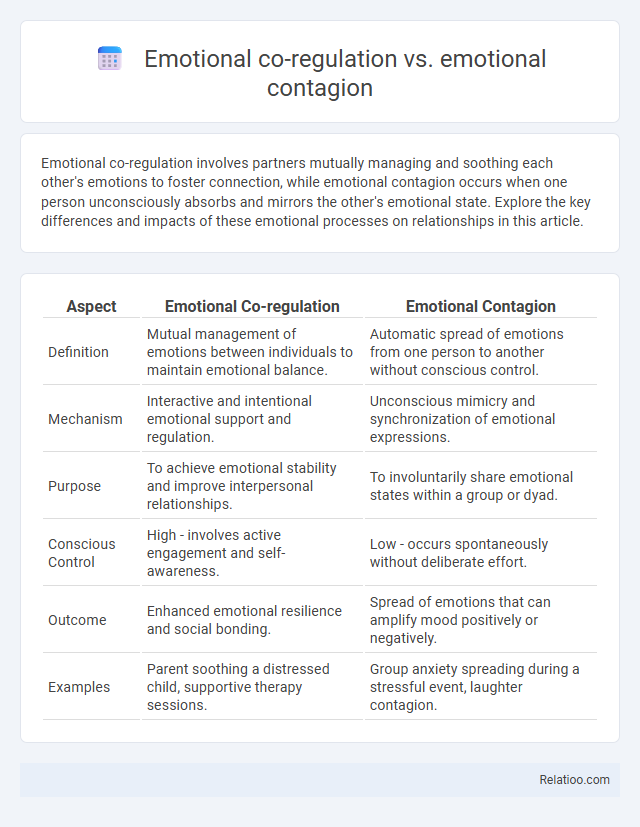Emotional co-regulation involves partners mutually managing and soothing each other's emotions to foster connection, while emotional contagion occurs when one person unconsciously absorbs and mirrors the other's emotional state. Explore the key differences and impacts of these emotional processes on relationships in this article.
Table of Comparison
| Aspect | Emotional Co-regulation | Emotional Contagion |
|---|---|---|
| Definition | Mutual management of emotions between individuals to maintain emotional balance. | Automatic spread of emotions from one person to another without conscious control. |
| Mechanism | Interactive and intentional emotional support and regulation. | Unconscious mimicry and synchronization of emotional expressions. |
| Purpose | To achieve emotional stability and improve interpersonal relationships. | To involuntarily share emotional states within a group or dyad. |
| Conscious Control | High - involves active engagement and self-awareness. | Low - occurs spontaneously without deliberate effort. |
| Outcome | Enhanced emotional resilience and social bonding. | Spread of emotions that can amplify mood positively or negatively. |
| Examples | Parent soothing a distressed child, supportive therapy sessions. | Group anxiety spreading during a stressful event, laughter contagion. |
Introduction to Emotional Co-Regulation and Emotional Contagion
Emotional co-regulation involves mutual support where two individuals manage and balance each other's emotions through responsive interactions, fostering emotional stability. Emotional contagion occurs when one person's emotions automatically trigger similar feelings in another, often unconsciously spreading moods within groups. Understanding how your emotional co-regulation differs from emotional contagion helps improve interpersonal connections and emotional awareness.
Defining Emotional Co-Regulation
Emotional co-regulation refers to the dynamic process where individuals mutually influence and manage each other's emotional states through responsive and supportive interactions, fostering emotional stability and resilience. Unlike emotional contagion, which involves the automatic and often unconscious spread of emotions from one person to another, emotional co-regulation emphasizes intentional and reciprocal emotional management. This concept plays a critical role in developmental psychology, particularly in caregiver-child relationships, where effective emotional co-regulation supports healthy emotional development and social competence.
Understanding Emotional Contagion
Emotional contagion refers to the automatic process by which individuals unconsciously mimic and synchronize emotions with others, often leading to shared emotional experiences. Unlike emotional co-regulation, which involves intentional and mutual efforts to manage emotions between people, emotional contagion occurs passively and can influence your mood without deliberate awareness. Understanding emotional contagion is crucial for recognizing how social environments shape your emotional state and for developing strategies to maintain emotional balance.
Key Differences Between Co-Regulation and Contagion
Emotional co-regulation involves two or more individuals actively managing and balancing each other's emotional states through supportive interactions, whereas emotional contagion occurs when feelings automatically spread from one person to another without conscious effort. Your ability to engage in co-regulation enhances emotional resilience by promoting mutual understanding and adaptive responses, contrasting with contagion's often unconscious transmission of emotions. Key differences lie in the intentional, reciprocal nature of co-regulation versus the automatic, unidirectional flow of contagion.
Mechanisms Behind Emotional Co-Regulation
Emotional co-regulation involves dynamic, reciprocal interactions where individuals mutually influence each other's emotional states through communication, facial expressions, and physiological synchrony, fostering emotional stability. Emotional contagion operates primarily through automatic, often unconscious mimicry of another's emotions, leading to shared affective experiences without deliberate regulation. The core mechanisms behind emotional co-regulation encompass bidirectional feedback loops, empathy-driven adjustments, and social signaling that enable synchronized emotional modulation and adaptive interpersonal connections.
How Emotional Contagion Occurs
Emotional contagion occurs when individuals unconsciously mimic and synchronize their emotions and behaviors with others, often through facial expressions, tone of voice, and body language. This automatic process transmits feelings such as joy, stress, or anxiety within social groups, influencing your emotional state without deliberate intention. Understanding emotional contagion helps differentiate it from emotional co-regulation, where mutual support actively manages and balances emotions between people.
Impact on Relationships and Social Dynamics
Emotional co-regulation enhances relationships by promoting mutual understanding and support, fostering a safe environment where you and others can manage emotions collaboratively. Emotional contagion often drives social dynamics through the automatic spread of feelings, which can either positively unify groups or escalate conflicts. In contrast, emotional co-regulation helps stabilize social interactions by encouraging conscious emotional management, leading to healthier, more resilient connections.
Emotional Co-Regulation in Parenting and Child Development
Emotional co-regulation in parenting involves the dynamic process where caregivers and children mutually influence and manage each other's emotional states, fostering secure attachment and emotional resilience. Unlike emotional contagion, which is the automatic mimicry and synchronization of emotions, co-regulation requires intentional responsiveness, helping children develop self-regulation skills and emotional awareness. Your active participation in emotional co-regulation supports healthy brain development and social competence, laying the foundation for long-term psychological well-being.
Strategies to Enhance Emotional Co-Regulation
Emotional co-regulation involves intentional strategies to synchronize emotional states between individuals, such as active listening, empathy-building exercises, and reflective communication techniques that promote mutual understanding and support. Emotional contagion, by contrast, is an automatic, unconscious process where individuals mimic and internalize others' emotions through facial expressions and tone of voice, often leading to shared emotional experiences without deliberate regulation. Strategies to enhance emotional co-regulation focus on cultivating mindfulness, practicing emotion labeling, and engaging in collaborative problem-solving to foster emotional resilience and interpersonal harmony.
Managing and Mitigating Emotional Contagion
Emotional co-regulation involves mutual support between individuals to manage and stabilize emotions, creating a balanced emotional environment. In contrast, emotional contagion refers to the automatic, often unconscious spread of emotions from one person to another, which can amplify stress and anxiety if not managed properly. Effective strategies for mitigating emotional contagion include fostering self-awareness, practicing mindfulness, and establishing clear emotional boundaries to prevent the escalation of negative emotions in group settings.

Infographic: Emotional co-regulation vs Emotional contagion
 relatioo.com
relatioo.com